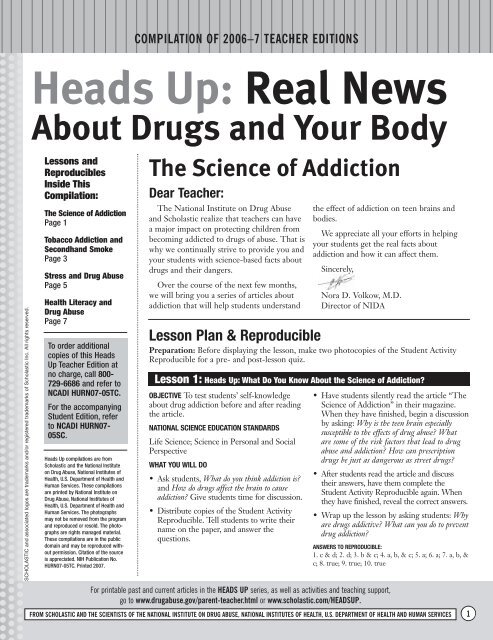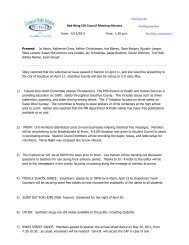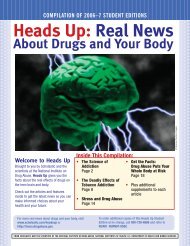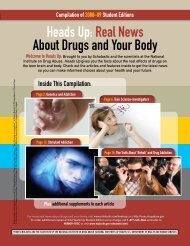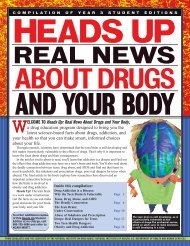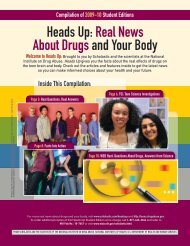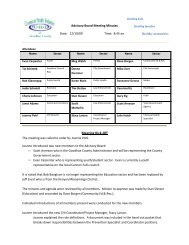Teacher Edition - Scholastic
Teacher Edition - Scholastic
Teacher Edition - Scholastic
Create successful ePaper yourself
Turn your PDF publications into a flip-book with our unique Google optimized e-Paper software.
COMPILATION OF 2006–7 TEACHER EDITIONSHeads Up: Real NewsAbout Drugs and Your BodySCHOLASTIC and associated logos are trademarks and/or registered trademarks of <strong>Scholastic</strong> Inc. All rights reserved.Lessons andReproduciblesInside ThisCompilation:The Science of AddictionPage 1Tobacco Addiction andSecondhand SmokePage 3Stress and Drug AbusePage 5Health Literacy andDrug AbusePage 7To order additionalcopies of this HeadsUp <strong>Teacher</strong> <strong>Edition</strong> atno charge, call 800-729-6686 and refer toNCADI HURN07-05TC.For the accompanyingStudent <strong>Edition</strong>, referto NCADI HURN07-05SC.Heads Up compilations are from<strong>Scholastic</strong> and the National Instituteon Drug Abuse, National Institutes ofHealth, U.S. Department of Health andHuman Services. These compilationsare printed by National Institute onDrug Abuse, National Institutes ofHealth, U.S. Department of Health andHuman Services. The photographsmay not be removed from the programand reproduced or resold. The photographsare rights managed material.These compilations are in the publicdomain and may be reproduced withoutpermission. Citation of the sourceis appreciated. NIH Publication No.HURN07-05TC. Printed 2007.The Science of AddictionDear <strong>Teacher</strong>:The National Institute on Drug Abuseand <strong>Scholastic</strong> realize that teachers can havea major impact on protecting children frombecoming addicted to drugs of abuse. That iswhy we continually strive to provide you andyour students with science-based facts aboutdrugs and their dangers.Over the course of the next few months,we will bring you a series of articles aboutaddiction that will help students understandOBJECTIVE To test students’ self-knowledgeabout drug addiction before and after readingthe article.NATIONAL SCIENCE EDUCATION STANDARDSLife Science; Science in Personal and SocialPerspectiveWHAT YOU WILL DO• Ask students, What do you think addiction is?and How do drugs affect the brain to causeaddiction? Give students time for discussion.• Distribute copies of the Student ActivityReproducible. Tell students to write theirname on the paper, and answer thequestions.the effect of addiction on teen brains andbodies.We appreciate all your efforts in helpingyour students get the real facts aboutaddiction and how it can affect them.Sincerely,Nora D. Volkow, M.D.Director of NIDALesson Plan & ReproduciblePreparation: Before displaying the lesson, make two photocopies of the Student ActivityReproducible for a pre- and post-lesson quiz.Lesson 1: Heads Up: What Do You Know About the Science of Addiction?• Have students silently read the article “TheScience of Addiction” in their magazine.When they have finished, begin a discussionby asking: Why is the teen brain especiallysusceptible to the effects of drug abuse? Whatare some of the risk factors that lead to drugabuse and addiction? How can prescriptiondrugs be just as dangerous as street drugs?• After students read the article and discusstheir answers, have them complete theStudent Activity Reproducible again. Whenthey have finished, reveal the correct answers.• Wrap up the lesson by asking students: Whyare drugs addictive? What can you do to preventdrug addiction?ANSWERS TO REPRODUCIBLE:1. c & d; 2. d; 3. b & c; 4. a, b, & c; 5. a; 6. a; 7. a, b, &c; 8. true; 9. true; 10. trueFor printable past and current articles in the HEADS UP series, as well as activities and teaching support,go to www.drugabuse.gov/parent-teacher.html or www.scholastic.com/HEADSUP.FROM SCHOLASTIC AND THE SCIENTISTS OF THE NATIONAL INSTITUTE ON DRUG ABUSE, NATIONAL INSTITUTES OF HEALTH, U.S. DEPARTMENT OF HEALTH AND HUMAN SERVICES1
STUDENT ACTIVITY REPRODUCIBLENameWhat Do You Know About the Scienceof Addiction?Answer the questions below to find out what you know about drugs and drug addiction.For multiple choice questions, there may be more than one answer.DateSCHOLASTIC and associated logos are trademarks and/or registered trademarks of <strong>Scholastic</strong> Inc. All rights reserved.1. Drug addiction can bedefined asa. a bad habit.b. the use of illegal drugs.c. a chronic, relapsingdisease.d. a complex anddevelopmentaldisease.2. Which of thefollowing arecharacteristics ofthe disease of drugaddiction?a. compulsive drugseekingb. neurochemicalchanges in thebrainc. molecular changesin the braind. all of the above3. The brain recognizesthe prescriptiondrug OxyContin inthe same way thatit recognizesa. caffeine.b. heroin.c. Vicodin.d. water.4. The diseaseof drug addictionis associated witha. HIV/AIDS.b. viral hepatitis.c. mental disorders.d. none of the above.5. The prefrontalcortex—locatedjust behindthe forehead—is the part ofthe brainthat governsa. judgment anddecision-making.b. speech.c. vision.d. movement.6. The PET in“PET scans”stands fora. positron emissiontomography.b. proton emulsiontomography.c. positron emissiontemperature.d. proton-electrontemperature.7. Which of the followingis a factor in whethersomeone becomesaddicted to drugs?a. genesb. environmentc. age of first used. none of the above8. Exposure to drugsduring the teen yearsmay affect thelikelihood of someonebecoming an addict inthe future.a. trueb. false9. Anyone who sellsmedications prescribedto them could be calleda drug dealer and issubject tocriminal prosecution.a. trueb. false10. People, places, andthings related to aparticular drugexperience can, at alater time, triggeranother drugexperience.a. trueb. false2FROM SCHOLASTIC AND THE SCIENTISTS OF THE NATIONAL INSTITUTE ON DRUG ABUSE, NATIONAL INSTITUTES OF HEALTH, U.S. DEPARTMENT OF HEALTH AND HUMAN SERVICES
STUDENT ACTIVITY REPRODUCIBLENameWhat Do You Know About the HealthEffects of Drug Abuse?Answer the questions below to find out what you know about the health effects of drugabuse and addiction.DateSCHOLASTIC and associated logos are trademarks and/or registered trademarks of <strong>Scholastic</strong> Inc. All rights reserved.1. A prescriptionmedicationa. is always safe becausea doctor prescribes it.b. is safe to take, evenif prescribed forsomeone else, as longas you have the samesymptoms.c. is safe to take, evenif prescribed forsomeone else, as longas you follow thedirections.d. is not safe for youif it has not beenprescribed for you.2. Diseased gums andteeth can result froma. methamphetamineb. cocainec. Vicodin ®d. opioids3. Which of the followingcan be a harmfuleffect of opioids likeVicodin ® andOxyContin ® ?a. “meth mouth”b. severe respiratorydepressionc. bone-marrow damaged. hearing loss4. Blackouts, hearingloss, and liver, kidney,and bone-marrowdamage are effects ofa. inhalantsb. methamphetaminec. cocained. nicotine5. Premature aging ofthe skin can resultfrom use ofa. tobaccob. cocainec. opioidsd. inhalants6. Effects of drug abusecan occura. when drugs areused at high dosesb. after prolongeduse of drugsc. after one used. any of the above7. The risk of contractingHIV/AIDS, hepatitis,and other infectiousdiseases is greatlyincreased bya. injection drug useb. risky behavior dueto drug abusec. both a and bd. none of the above8. The main chemicalfound in tobacco thatcauses addiction isa. tarb. caffeinec. nicotined. menthol9. More than half ofpeople addicted todrugs have alsohad some form ofmental illness.a. trueb. false10.Drug abuse is linkedto the top medicalproblems in theUnited States.a. trueb. false8FROM SCHOLASTIC AND THE SCIENTISTS OF THE NATIONAL INSTITUTE ON DRUG ABUSE, NATIONAL INSTITUTES OF HEALTH, U.S. DEPARTMENT OF HEALTH AND HUMAN SERVICES


